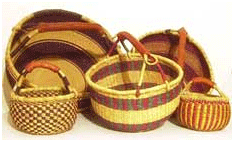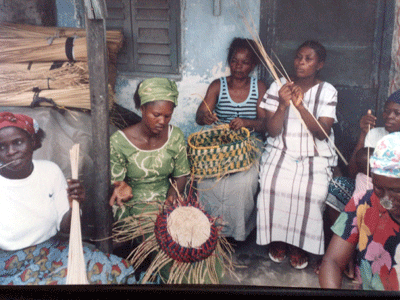The Instrument Makers
In the following photos you can see the skilled instrument makers who supply many of the instruments we use. You can follow the process of creating a Djembe from raw materials and see how the Xylophone is constructed.
Christopher Doozie’s Xylophone workshop in Mpe-Asem, Accra, Ghana.
The Late Louis Botchway and son Francis Botchway’s Drum workshop in Madina, Accra, Ghana.
Kasena Nankeni: Dances
Nagla:
A dance performed by the Kasena Nankeni people of Paga and Navrongo in the Upper East Region of Ghana. In the olden days, it was performed at funerals but today, even though it still maintains this function, it can also be seen on most social occasions excluding marriage ceremonies. Movements in Nagla reflect the spirit of togetherness.
Kasena Nankeni: Culture
The Bolga Basket:
 TEA (spoken Te – A ) basket with handle is produced in Bolgatanga.
TEA (spoken Te – A ) basket with handle is produced in Bolgatanga.
Two types of weaving are done (and most weavers only know one of them): It is double weaving (two uprights and thin straw) and single weaving (one upright and thicker straw). If the basket has reached its size a mouth has to be done. Here uprights are combined and bundled round. The handle is woven inside that mouth, is combined in the middle and bundled round with straw. The end of the straws on the baskets are cut with a blade. The TEA is ready.
Now there is till the leatherwork to be one on the basket: The handle is sawn around with goatleather, which increases the comfort of carrying a basket and also increases its stability and durability.
The Bolga Basket Weaver:
 In north-east of Ghana, near to the border to Burkina Faso, Bolgatanga is situated, where the Frafra are the original settlers. (Scientifically spoken the Frafra are a larger ethical group, and the weavers belong to the smaller tribe of the Gurunsi. In Ghana however the weavers call themselves Frafras.) In this area about 120.000 people are living and not in every house or compound families or villages weaving is a predominant vocation.
In north-east of Ghana, near to the border to Burkina Faso, Bolgatanga is situated, where the Frafra are the original settlers. (Scientifically spoken the Frafra are a larger ethical group, and the weavers belong to the smaller tribe of the Gurunsi. In Ghana however the weavers call themselves Frafras.) In this area about 120.000 people are living and not in every house or compound families or villages weaving is a predominant vocation.
Whilst agriculture – despite the poor soils of the Sahel zone – is the major occupation (millet, guinea corn, maize, groundnuts, beans, cattle and animal rearing) about 4000 people do weaving as a part time or even full-time occupation.
Most of them however see weaving as a side or additional occupation, as agriculture for self-sufficiency is their major profession. During the main farming season, weaving is neglected a little to give enough time for the harvest.
Out of the 4000 weaver we from Fairtrade Producer Society (FPS) co-operate and work together with 980 (survey and group registration 2002). They are from three villages: Gambigo, Nyarga and Sumbrungu.
In the individual compounds the weaver groups are organised like a family is together. To the outside, meaning towards the market and also our man Abu Sadik or Accraboy they are represented by their leaders. The Leaders – different for men and women – are the link to the market and are selected from the groups (families, between 5 and 30 people) themselves. Theirs is a service function: negotiate price, collect straw, collect money, transport baskets and straw, serve as communication link, such as orders, quantities, colours, style. In case of discrepancies the leader is sacked.
Dagaare: Musical Instruments
The Gyil:
The Lobi Gyile.
Kakraba Lobi
https://www.youtube.com/watch?v=Z73DP1i1_KM
The Sasaala Gyile
The Dagare Gyile
Aaron Sukra Bebe
https://www.youtube.com/watch?v=OAqmo9ovaSQ
The Modern Xylophone:
The xylophone tuning is a rather relative one ( not getting the perfect C or other key) but rather it equalises the intervals.The keys are assembled on the frame with the gourds by a rope from twisted antelope skin. Or more commonly now nylon rope.The wood for the keys is rare and can only been found in the Savannah and grassland zones of Northern Ghana and some areas that extend to Burkina Faso. For a tree to be used it must have died roughly five years previously, say in a bush fire. It will then be cut down cut into planks and the placed in a home made kilm for 5 days untill the moisture and all from the wood is gone.
Music by xylophone:
Christopher Doozie, the xylophone maker, player and teacher:
Dagaare: Dances
Bewa:
One of the oldest traditional dances of the Dagaare speaking people of the Upper west Region of Ghana. Bawaa is a ritual and ceremonial dance performed to celebrate the beginning and end of the rainy season, good harvest, New Year and other social events.Bamaaya
Bamaaya, meaning, “The river (valley) is wet”, is the most popular social music and dance of the Dagbamba of Northern Ghana. It began as a religious musical performance, but now functions during funerals, festivals, national day celebrations, and other social occasions. Dancing the Bamaaya requires a lot of waist movement and twisting. The maiden name for this music and dance, Tubankpeli, is now the main dance movement. Originally, only men took part in the dance while the women would sing, shout praises, and encourage the dancers. Now, Bamaaya is for both genders.
Ga: Culture
Location:
Religion:
Festivals:
Traditional Power:
Music:
Language:
Economic:
Ga: Musical Instruments
- Kpanlogo
- Aslama
- Tamalin
- Gome
- Goumbe
- Pati
- Apentibin
- Pod Bell
- Bamboo Sticks
- Double Bell
Ga: Dances
Gome:
Gome is one of the oldest musical types performed by the coastal Ga of Ghana, which was introduced by Accra fishermen from the Fernando Po Islands in the early eighteenth century. Originally, Gome was performed exclusively by fishermen after their expeditions to celebrate their catch. Other occupational groups, especially artisans, also eventually adopted this music and dance as a form of entertainment. Presently, Gome is performed by all categories of people– young and old, male and female, on all social occasions
Kpanlogo:
Kpanlongo is the most recent of all Ga recreational musical types, an offshoot of Gome, Oge, Kolomashie, and Konkoma. Referred to as “the dance of the youth,” Kpanlongo started during the wake of Ghana’s Independence as a musical type for entertainment in Accra. Kpanlongo is presently performed at life-cycle events, festivals, and political rallies.
- Instruments
- Slit Bell – Nono
- Double Bell – Nononta
- Pod Bell – Dodompo
- Lead Drum – Atswereshi
- Support Drums – Atswereshi x 2
- Frame Drums – Tamlali x 1 or 2
- Bass Drum – Gome
The Kpanlogo dance was invented by Otoo Lincoln. He was told an Ansee folk story by his Grandfather. Kpanlogo, Mma Mma and Algodzan were the names of three triplets girls. Their father was the cheif and said, how ever could guess their names could marry them. So a man went to their home pretending to be a mad man asking for water, he met the girls and learnt their names as they called to each other. To remember them he kept singing to himself ‘Kp. Mma. Al.’ And of course he married the girls. Otoo heard the story in 1956 when he was 15. He used to tell it dancing and singing to his brothers and sisters, a friend used to drum along as they liked the music and dance and we created our own version of highlife around 1962. The feeling of the music originated from music played by his father from Oge , Liberian music a sort of slow kpanlogo. I mixed this Oge with high life and rock and roll to produce the feeling in Kpanlogo.
In 1962 the Arts Council, banned its playing as one of the beats made the body move in an indecent way. They called Otoo in for a meeting. Otoo said that it ………………… By 1965 Kpanlogo had become so popular that 50+ groups performed it to the head of state Nkrumah.
Kpanlogo was seen as a dance from the youth, arising from the streets of Accra soon after Ghana’s independence, and symbolised the youth and independence of a young nation and so was taken on and played at funerals, state occasions and became an anthem for the ruling party at the time. Up to now its popularity remains hi. There are countless Kpanlogo performing groups, playing for pleasure and at all social and state occasion.
Kpatsa:
Kpatsa is the principal traditional entertainment music and dance of the Dangme of Ghana, in West Africa. The dance itself involves sideways and forward shuffling movements, making use of short, brisk steps with the body slightly bent. The dance steps move the dancer either diagonally or backwards. With arms bent in front of the body, the right leg steps in concert with the movement of the right arm while the left leg steps at the same time as the left arm; while one foot remains flat on the ground, the heel of the other foot is lifted off the ground.
Ga: History
The Ga- Adagmes migrated from Nigeria through Benin and Togo, settling on the coast of Ghana around the 13th Century.
They live along the coast of Ghana around the capital city Accra, towards the Togo border, as well as in the hills and mountains north of the Coast.
They were farmers, fishermen, salt miners, blacksmiths, potters, weavers, bead makers and hunters and hunters. All these professions are still found, but being around the developing capital, commerce has taken over a major aspect of their economic ventures.

















































